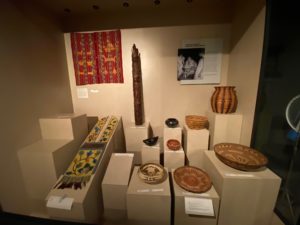
The new installation of our “Indigenous Americas” case in progress in our Decorative Arts gallery.
During the closure of the McClung Museum due to Covid-19, our staff have been hard at work installing new objects in our gallery, The Decorative Experience. Currently, we are putting the finishing touches on these new installations in the gallery. We have also been digitizing the records of objects on display in this gallery so more of our collections are accessible online.
Today, we highlight a Hopi basket plaque made by an unknown artist from Third Mesa (Oraibi), Arizona, and on display in our galleries for the first time.

Basket plaque, c. 1900, Unknown Hopi Artist, Third Mesa (Oraibi), Arizona, Willow, yucca, and dye, Gift from Mrs. Kenneth Gilpin from her parents collection, 1960.7.3.1.
The shallow wicker baskets known as basket plaques are called yungyapngölökpu in the Hopi language. Using local plants dyed with natural or commercial dyes, the designs of the basket plaques represent natural, geometric, or animal forms. This basket features a spider web design of concentric circles, representing Spider Woman—a powerful teacher and helper figure who taught the Hopi to weave.
“The spider woman is the wisdom keeper, the grandmother figure, the female figure. When I wanted to get out from my illness, there was a spider woman in my mind who spoke to me, and she became my strength and my courage to pull me out.”
—Hopi artist Michael Kabotie
While basket plaques are often sold on the tourist market, they continue to be an important part of Hopi culture. Plaques are woven for family members, friends, and neighbors as part of rituals, as gifts to reaffirm social ties, and as thanks for favors or work. In this way, the exchange of plaques “facilitates harmonious relations, establishment of new kinship ties, [and] sharing of goods.”
As plant expert and Hopi weaver Ruby Chimerica explains in the video below, she doesn’t call her plaques art, because “it’s a part of me.” She goes on to explain that while she sells her baskets for money, in addition to gifting them, she can’t put a price on her baskets because the plant life is priceless.